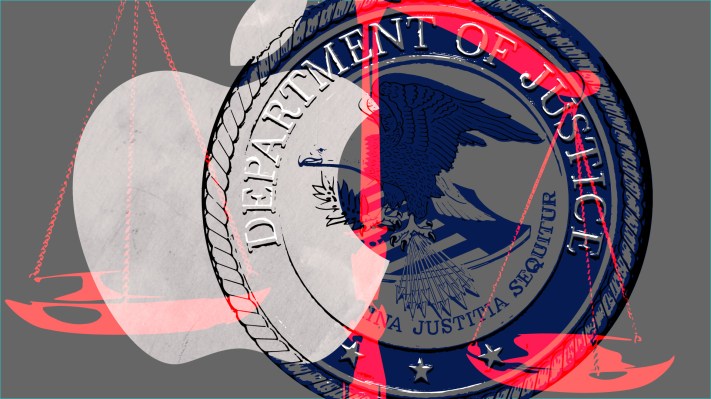U.S. regulators are accusing Apple of operating like a monopoly, and the implications of the case stretch far beyond iOS and iPhones themselves

Apple’s antitrust scrutiny has reached a fever pitch. The U.S. Department of Justice announced Thursday that it filed a lawsuit accusing the company of behaving like a monopoly in locking in iPhone customers and limiting competitors building hardware and software. The lawsuit, which comes on the heels of significant antitrust cases against Apple outside the U.S., is a wide-ranging and complicated affair, but we’re covering the ins and outs of the DOJ’s case, the industry’s response and all the ongoing implications for companies and customers.
We’ll be updating this page as the Apple antitrust case evolves, but keep in mind that there will be little settled in the short term. Experts estimate a three-to-five-year timeline for any resolution for the case.
The DOJ’s claims against Apple
If you want to dive into legal docs immediately, you can read the DOJ’s lawsuit right here. But for the rest of us, there are five categories that the complaint identifies as areas in which Apple actively suppressed competition.
“Super” apps: These are applications that contain numerous functions within a single app. This should ring a bell for anyone following Elon Musk’s “everything app” aspirations for X, and the DOJ claims Apple is inhibiting their success to increase dependence on the iPhone.
Messaging apps: The blue bubble, green bubble effect is specifically cited by the DOJ as a factor discouraging iPhone users from adopting a competitor device. “This effect is particularly powerful for certain demographics, like teenagers — where the iPhone’s share is 85 percent, according to one survey,” the DOJ said in the lawsuit.
Cloud streaming gaming apps: The DOJ lawsuit highlights Apple’s alleged opposition to cloud-based gaming, claiming its actions are to prevent consumers from playing games “without the need for users to purchase powerful, expensive hardware.” (Page 33 for reference.)
Digital wallets: Though the 0.15% fee Apple takes for all transactions made through Apple Pay is a fraction of the company’s total revenue, the DOJ alleges that the ubiquity of Apple Pay within its mobile ecosystem means it has “complete control” over users’ NFC payments and that it hinders competitors.
Smartwatch cross-platform compatibility: This DOJ claim is straightforward. By limiting the functionality of Apple Watches with non-iPhone devices, the lawsuit claims “it becomes more costly for that user to purchase a different kind of smartphone.”
Apple, and the wider industry’s, response
Apple issued an extensive series of rebuttals to the DOJ’s claims Thursday, which you can check out in full detail right here. The core of Apple’s argument is that regulators are selectively picking metrics that make Apple’s strength in the smartphone market seem more dominant than it actually is, in their view. And in regulating the behaviors that the DOJ claims are monopolistic, Apple’s competitive advantage in the market would be diminished and iPhone customers negatively impacted in the process.
“This lawsuit threatens who we are and the principles that set Apple products apart in fiercely competitive markets. If successful, it would hinder our ability to create the kind of technology people expect from Apple — where hardware, software, and services intersect,” Apple said in a statement provided to TechCrunch
App makers are less critical of the DOJ’s case, with the Coalition for App Fairness (CAF) voicing strong support for the DOJ’s regulatory action, which comes as no surprise given several of its members, like Epic Games and Spotify, have already had public disputes with Apple on its App Store practices.
“The DOJ complaint details Apple’s long history of illegal conduct — abusing their App Store guidelines and developer agreements to increase prices, extract exorbitant fees, degrade user experiences, and choke off competition,” CAF Executive Director Rick VanMeter said in a statement Thursday. “The DOJ joins regulators around the world, who have recognized the many harms of Apple’s abusive behavior and are working to address it.”
What’s next for Apple antitrust
In the immediate term, not much. The release of the lawsuit, and the ensuing back-and-forth between Apple and the DOJ, was a flurry of activity that will take years to settle. The DOJ’s antitrust case against Google, which was filed back in 2020, went to trial last year and could still take a couple more years to reach a conclusion.
What you shouldn’t expect is for the present to play out like the past. Though the DOJ cites the successful antitrust prosecution against Microsoft in the 1990s, there are many distinctions between the two cases, mostly notably a gap between how easily defined Microsoft’s market dominance was compared to Apple’s current status quo.
For more on Apple’s antitrust lawsuit, check here:
techcrunch.com




